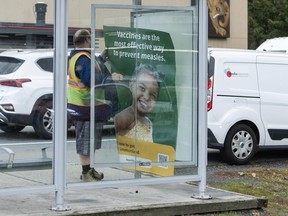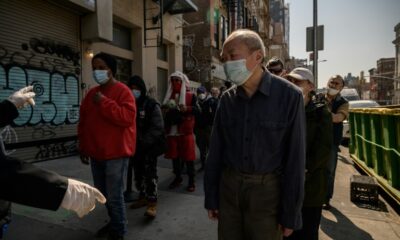Health
B.C. Childhood Vaccination Rates Decline Post-COVID-19 Pandemic

Childhood vaccination rates in British Columbia have not rebounded from a decline that began during the COVID-19 pandemic, according to data released by the B.C. Centre for Disease Control (BCCDC). This troubling trend highlights a more complex issue beyond just pandemic-related disruptions.
As the province encourages residents to book appointments for seasonal flu and COVID-19 vaccinations, data reveals a “small-to-medium decline” in routine childhood immunizations since 2021. Dr. Jia Hu, the interim medical director of immunization programs at BCCDC, reported that vaccination rates among seven-year-olds have fallen significantly. Currently, more than one-third of second-graders are not up-to-date on essential vaccinations for diseases such as mumps and measles.
Vaccination Rates Drop
The overall immunization rate has decreased from 72.5 percent in 2021 to 63.8 percent in 2024. Dr. Hu noted that while the pandemic made some vaccines harder to access, this is only part of the story. He explained that the number of children with “documented refusals”—those whose parents have explicitly opted against vaccination—has remained stable, suggesting that the actual immunization rate could be higher than reported. Issues such as children vaccinated in other provinces or countries not being accounted for may also contribute to the lower numbers.
Moreover, Dr. Hu indicated that after a period of high migration, gaps in immunization coverage are not unusual, particularly when parents may not have had the opportunity to update their children’s health records. Notably, data for two-year-olds also reveals a concerning trend, showing that vaccination rates for toddlers born after the peak of COVID-19 are lower than those recorded between 2016 and 2020, when rates were consistently between 73 percent and 74.3 percent. In 2024, only 69.5 percent of two-year-olds in B.C. were up to date with their routine vaccinations.
Emerging Vaccine Hesitancy
Vaccine hesitancy has emerged as a significant factor impacting immunization rates. A recent poll conducted by Angus Reid revealed that one in six Canadian parents with children under 18 expressed strong opposition to vaccinating their kids, marking a significant increase since 2019. The proportion of parents who were uncertain about vaccinating their young children also doubled, rising from 8 percent to 16 percent in that time frame. This rising skepticism about vaccines has led Brian Conway, medical director of the Vancouver Infectious Diseases Centre, to label the situation “a disaster of epic proportions.”
Despite these challenges, B.C. has seen some improvements in vaccination coverage as children age. Public health clinics in Grade 6 and Grade 9 offer scheduled vaccinations, which help to address missed immunizations. Data indicates that by Grade 9, coverage for all vaccines has increased since the lows observed in 2021, as the prioritization of COVID-19 responses affected public health resources.
In a positive development, there has been a “dramatic increase” in the uptake of the measles-mumps-rubella vaccine, with a reported jump of 30 to 40 percent this year compared to last. Experts believe that the rise in measles infections, with 102 cases reported across the province as of July, has motivated more residents to seek vaccinations.
As of 2024, measles immunization coverage for seven-year-olds stands at 70 percent, compared to over 80 percent for German measles and hepatitis B. Health officials are actively using immunization data to tailor vaccination campaigns to regions with the lowest rates.
The Kootenay Boundary region recorded the lowest immunization coverage for seven-year-olds in 2023 at 54 percent, with the Okanagan following at 60 percent. The lowest rates in the Fraser Health region were observed in Fraser North at 63.4 percent and Vancouver at 63 percent, while the highest coverage was in the Northern Interior at 75.6 percent.
To address immunization gaps, the province is also focusing on increasing rates for the human papillomavirus (HPV) vaccine by simplifying the vaccination schedule and expanding eligibility for individuals aged 19 to 26. In 2023, the HPV vaccination rates for females in Grade 9 were at 60 percent and 57.7 percent for males.
As the province continues to send notifications for seasonal flu and COVID-19 vaccination appointments, it remains crucial for health officials to encourage participation in immunization programs, particularly as vaccines are available at no cost.
-

 Lifestyle2 months ago
Lifestyle2 months agoWinnipeg Celebrates Culinary Creativity During Le Burger Week 2025
-

 Health2 months ago
Health2 months agoMontreal’s Groupe Marcelle Leads Canadian Cosmetic Industry Growth
-

 Science2 months ago
Science2 months agoMicrosoft Confirms U.S. Law Overrules Canadian Data Sovereignty
-

 Education2 months ago
Education2 months agoRed River College Launches New Programs to Address Industry Needs
-

 Technology2 months ago
Technology2 months agoDragon Ball: Sparking! Zero Launching on Switch and Switch 2 This November
-

 Science2 months ago
Science2 months agoTech Innovator Amandipp Singh Transforms Hiring for Disabled
-

 Technology2 weeks ago
Technology2 weeks agoDiscord Faces Serious Security Breach Affecting Millions
-

 Technology2 months ago
Technology2 months agoGoogle Pixel 10 Pro Fold Specs Unveiled Ahead of Launch
-

 Science2 months ago
Science2 months agoChina’s Wukong Spacesuit Sets New Standard for AI in Space
-

 Technology2 months ago
Technology2 months agoWorld of Warcraft Players Buzz Over 19-Quest Bee Challenge
-

 Education2 months ago
Education2 months agoAlberta Teachers’ Strike: Potential Impacts on Students and Families
-

 Technology2 weeks ago
Technology2 weeks agoHuawei MatePad 12X Redefines Tablet Experience for Professionals
-

 Business2 months ago
Business2 months agoDawson City Residents Rally Around Buy Canadian Movement
-

 Business2 months ago
Business2 months agoNew Estimates Reveal ChatGPT-5 Energy Use Could Soar
-

 Science2 months ago
Science2 months agoXi Labs Innovates with New AI Operating System Set for 2025 Launch
-

 Technology2 months ago
Technology2 months agoInnovative 140W GaN Travel Adapter Combines Power and Convenience
-

 Technology2 months ago
Technology2 months agoFuture Entertainment Launches DDoD with Gameplay Trailer Showcase
-

 Technology2 months ago
Technology2 months agoGlobal Launch of Ragnarok M: Classic Set for September 3, 2025
-

 Technology2 months ago
Technology2 months agoNew IDR01 Smart Ring Offers Advanced Sports Tracking for $169
-

 Education1 month ago
Education1 month agoBrandon University’s Failed $5 Million Project Sparks Oversight Review
-

 Business2 months ago
Business2 months agoBNA Brewing to Open New Bowling Alley in Downtown Penticton
-

 Technology2 months ago
Technology2 months agoArsanesia Unveils Smith’s Chronicles with Steam Page and Trailer
-

 Science2 months ago
Science2 months agoNew Precision Approach to Treating Depression Tailors Care to Patients
-

 Technology2 months ago
Technology2 months agoHumanoid Robots Compete in Hilarious Debut Games in Beijing










